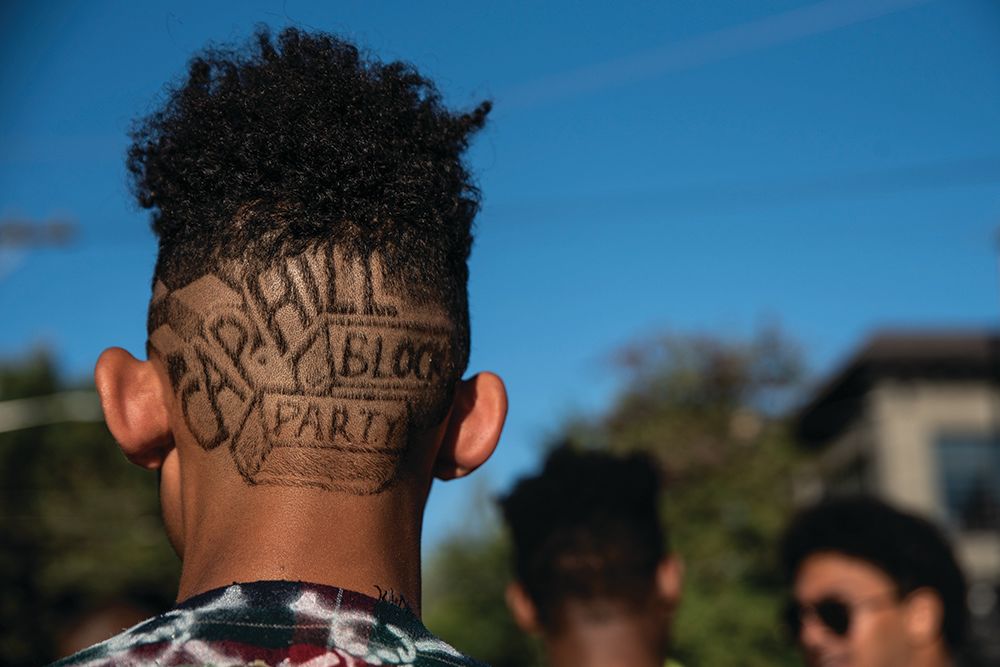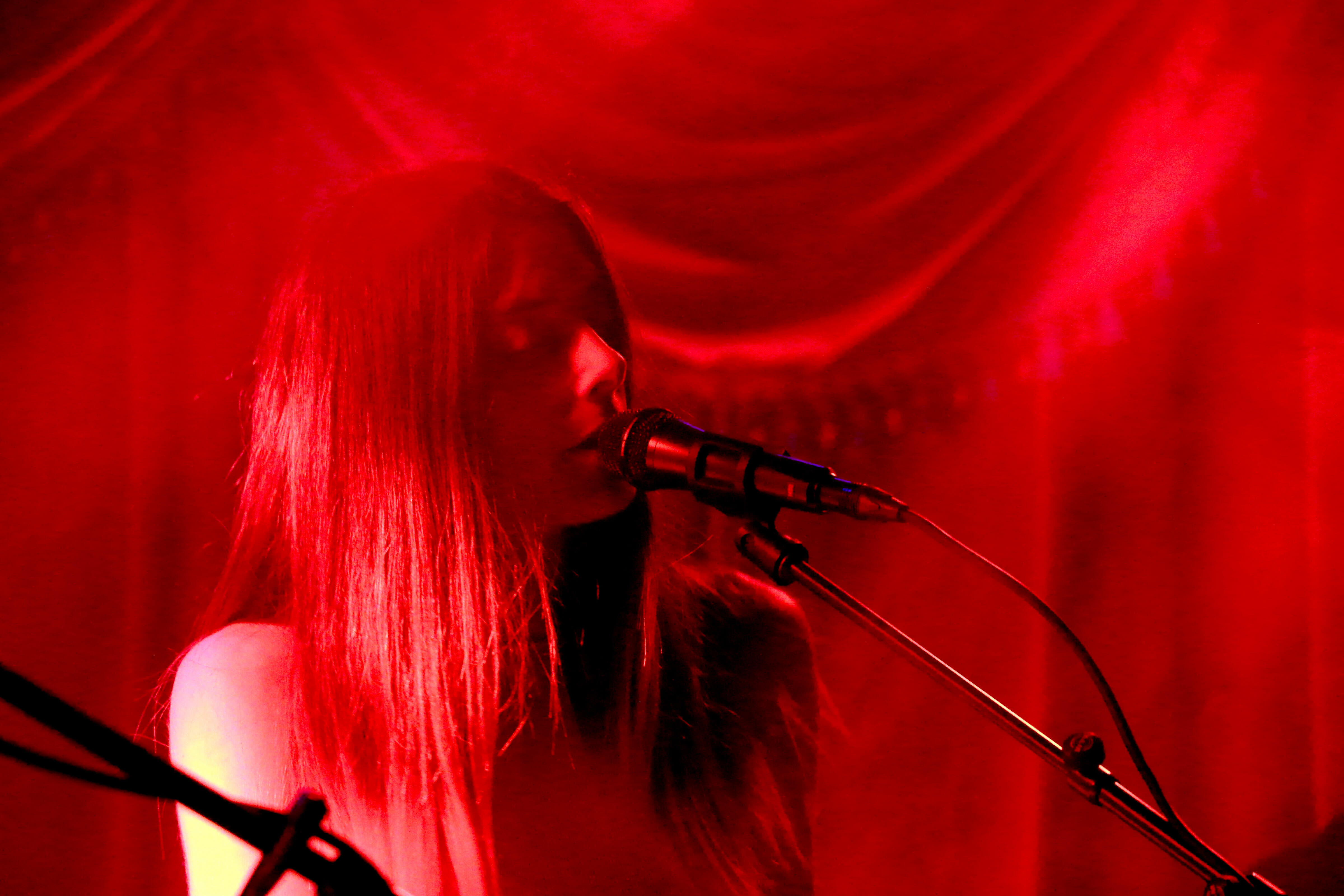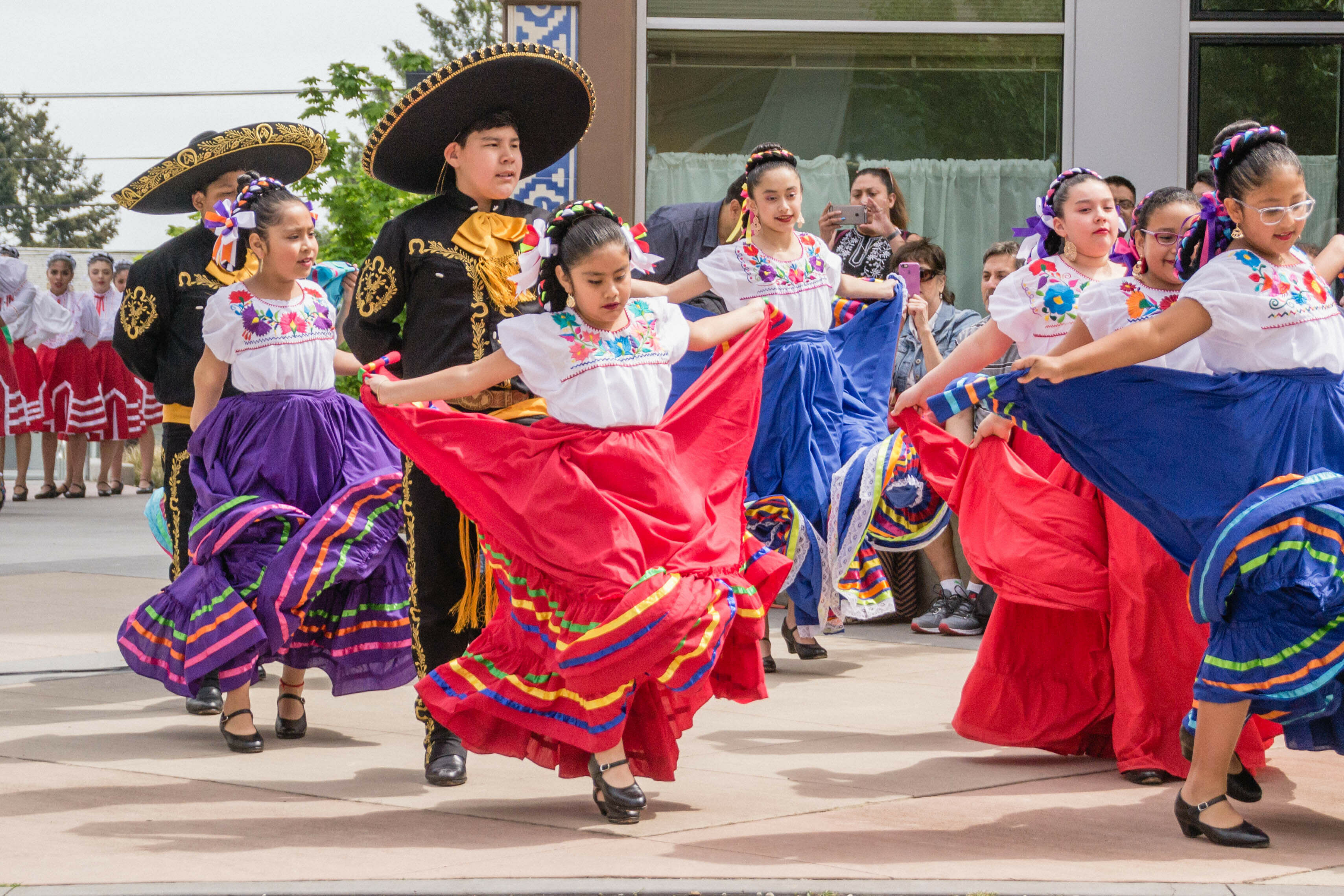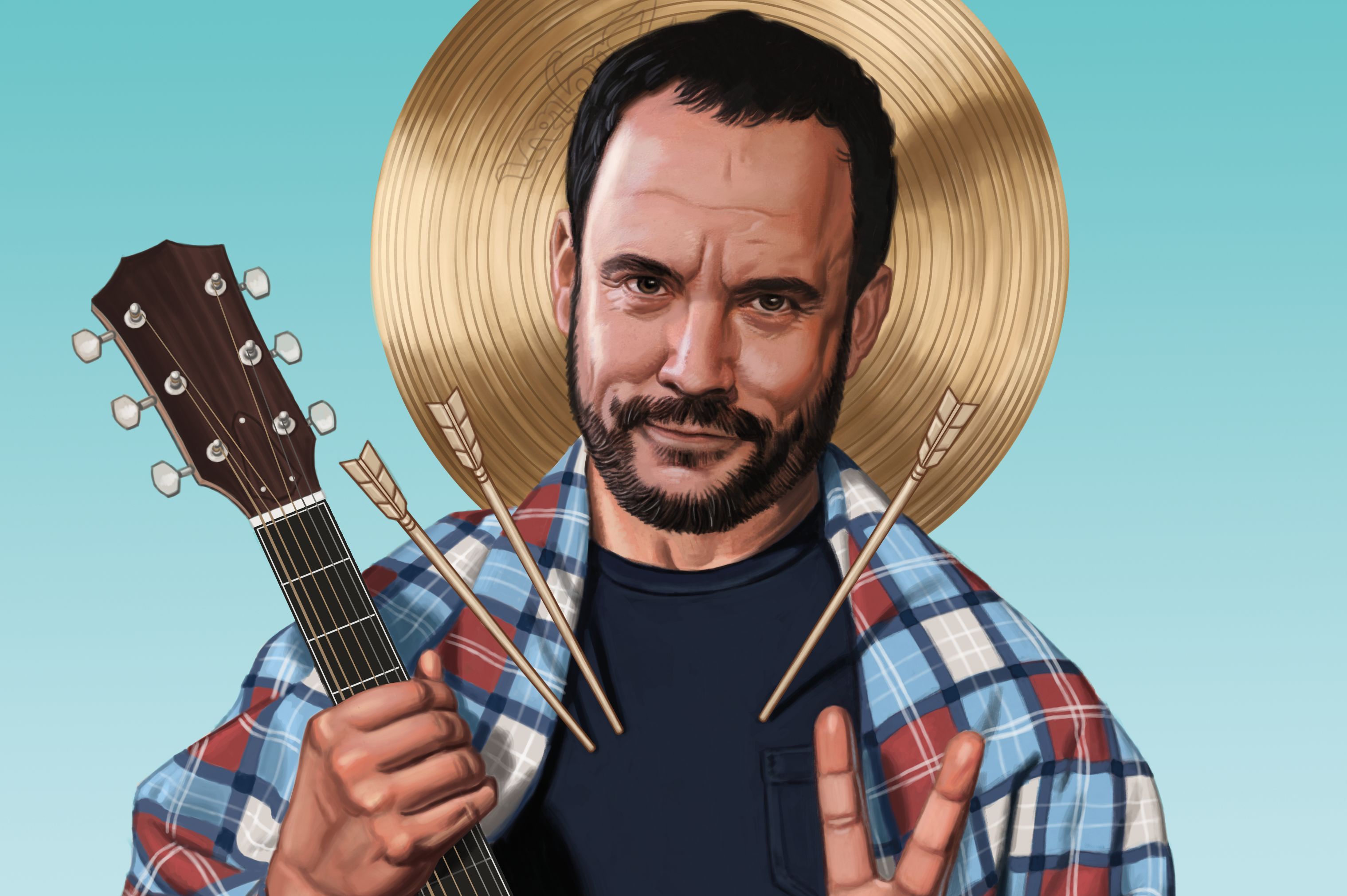
The Sainthood of Dave Matthews Has Been Indefinitely Postponed
Illustration by Scott Anderson
When the sun sets on the Columbia River, behind the boxy stage of the Gorge Amphitheatre, the scene’s as placid and vivid as a nineteenth century landscape painting. This is nature as those Romantic artists would’ve rendered it, brutal, sublime. The rock cliffs are lined like a layer cake in browns and tans, topped with the Central Washington sky in a watercolorist’s pink and blue. But now that the August sky has almost fully turned dark, the star of the show finally strolls mid-stage before 20,000 people fanned like congregants and goes directly into the first song.
The first sound the band makes is…a hiccup.
And nearly all 20,000 break into woos and screams of appreciation, because that “Hhuunc!” from lead singer Dave Matthews is the first lyric of “Pig,” an old standby from the 28-year-old band. It gets a lot more intelligible after the first nonsense noises; a jam about enjoying the here and now. A plea to “don’t burn the day away” in case “a great wave should wash us all away.” You know, carpe diem and all that.
The audience has interpreted that edict as an embrace of all things comfortable, clad in plaid flannels or hoodies or plaid flannels layered over hoodies. One trio wears matching lime-green shirts printed with the Tommy Boy callout “Holy Schnikes!” and nonmatching baggy cargo shorts. Some raise $25 big plastic goblets of strawberry frosé. The air smells like weed. Of course it smells like weed.
Of the thousands here, about half have stepped out of RVs and those big square tents you buy at Target parked on thousands of campsites spread on the festival grounds that fan out from the amphitheater.
Here, 150 miles east of Seattle, a 51-year-old man rocking the ultimate dad bod holds court, as he’s done for decades on summer stints that have become like annual tent revivals. What most of the crowd doesn’t consider is how deep Dave Matthews’s local ties run—that he lives in Seattle, enrolls his kids in Seattle schools. That Dave Matthews is Seattle’s biggest rock star.
No, really. It just depends a little on how you define “biggest.” And “rock,” and “star.” And, now that you mention it, “Seattle’s.”
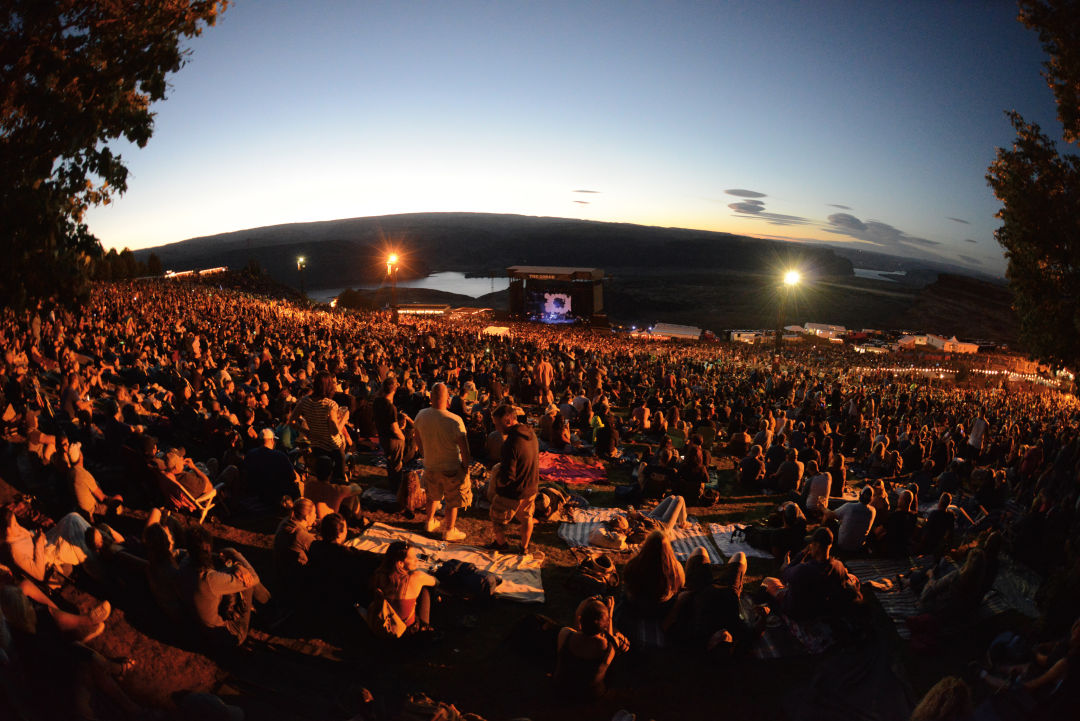
The audience at DMB's 2018 Gorge performance.
Image: Adam McCullough
Though the band formed in a Virginia college town back in 1991, Dave Matthews has been a Seattle resident since Bush II’s first term. His eponymous band has sold more than 33 million records, right behind Bob Dylan and Queen on lists of the best-selling recording artists of all time.
In 2014, Billboard marked them the seventh most successful touring band since 1990, noting their then-$777 million gross haul—it’s probably around a billion by now—outpaced Paul McCartney and Metallica. The Recording Industry Association of America ranks the Dave Matthews Band in their top 50, with gold and platinum stats similar to U2’s.
The only Seattle band—and we’ll get to DMB’s Emerald City bona fides in a second—that comes close to that longevity or success is one that formed a year earlier than Matthews’s crew: Pearl Jam. And while no one’s going to deny that Eddie Vedder and Co. are a quintessential Seattle outfit, before this year’s Home Shows at Safeco Field they hadn’t played the city in five years.
Both are wildly successful music acts, the top 1 percent of 1 percent of dudes who sing songs for a living. But if you believe the stats on the internet—big grain of salt here—Eddie Vedder has a net worth of $100 million, but Dave Matthews is sitting on three times that.
For two decades Matthews has parked his jam band circus at the Gorge and he’s funded progressive causes. His photos hang next to platinum records from Death Cab for Cutie, Sir Mix-a-Lot, and Nirvana at Robert Lang Studio in Shoreline—the Northwest’s most hallowed recording spot.
When KEXP fundraised for their new Seattle Center studio in the mid 2010s, three big bands showed up with cash: “Macklemore and Ryan Lewis came through, Pearl Jam came through,” says longtime DJ and program director John Richards. “And Dave Matthews.” This in spite of the fact that while KEXP’s airwaves might blast “Thrift Shop” or “Jeremy,” the station doesn’t even play DMB.
There’s a Dave Matthews shaped hole in the public idea of the Seattle sound, and neither Matthews nor the Emerald City seems interested in changing that. Why do two wildly successful entities—a music man and a music city—have so little to do with each other?
When I tell Seattle music critic Charles R. Cross that I’m writing about the Dave Matthews Band, he immediately quips, “Why? Did you lose a bet with your editor?”
Sometime in the past two decades, the group’s ubiquity seeped into the national consciousness so thoroughly that the band and the man melded into one familiar entity, “Dave.” And to most, “Dave” became unbearably irritating.
The punchlines were mockery wrapped up in derision of cargo shorts and ultimate Frisbee. Basic, before “basic” was an insult. For a whole generation of late-stage Gen Xers, the DMB posters that papered their dorm rooms have become as embarrassing as that ’90s men’s haircut with floppy side bangs. Try it. Mention Dave Matthews Band anywhere in Seattle and look for the knowing cringe.
DMB made it so easy. There was the Day Dave Matthews Band Pooped on Chicago: On August 8, 2004, one of the band’s busses—that Dave wasn’t on at the time—emptied its sewage tank through the grated roadway of the Windy City’s Kinzie Street Bridge. Right on an open-air boat of sightseers on an architecture tour. The bus driver was hit with fines, but the metaphor of Poopgate was, well, easy pickings.
In 2012, LA Weekly ranked the “Top 20 Worst Bands of All Time,” roasting a murderers’ row of earnest pop rockers and superficial corporate outfits, the Spin Doctors to the Pussycat Dolls. Dave Matthews Band came out on top, a group who “[makes] Perrier seem vibrant and ethnic,” as columnist Jeff Weiss wrote. The next year Rolling Stone readers voted DMB the 10th worst band of the ’90s.
It’s worth noting that a few other Seattle groups turned up on those lists: Pearl Jam on one, Nirvana on the other. Maybe it was simply the backlash that comes with success. But in October of this year, when DMB first became eligible for the Rock and Roll Hall of Fame, it was snubbed by the nominating committee.
John Richards, the longtime KEXP DJ, heaped his fair share of scorn on the band at first; in 1995 he reluctantly saw them live at Chateau Ste. Michelle winery in Woodinville. “Because of a girl,” he says ruefully.
Richards was a self-proclaimed music snob, still three years from hosting The Morning Show at KEXP. His hair was long, down to his shoulders, and he had a nose ring. More than 20 years out he’s pretty sure he was wearing long johns that August day, “like a stereotype of the stereotype” of a grunge acolyte. Irritated, he walked up the winery’s gravel road, a bucolic contrast from the sticky floors of the Crocodile Cafe he frequented.
Richards sat there with that chip on his shoulder, on a scenic field lined with lawn chairs, like a JV version of the Gorge fests to come. And as the band played, he had to admit it: “They’re really good, like they’re very good live,” he says, remembering. As a kid who was used to jumping in the pit at rock concerts—“like got almost killed at a couple of shows”—this loose musicality impressed him. “This was a grown-up band.”
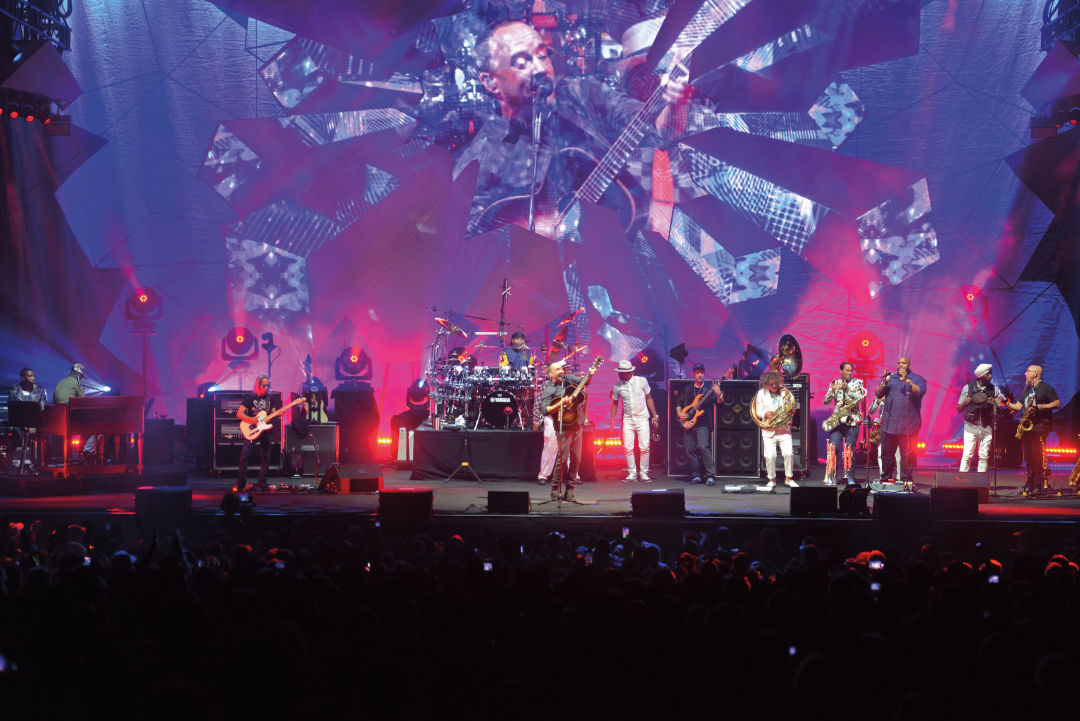
Dave Matthews Band performs at the Gorge in 2018, joined onstage by the Preservation Hall Jazz Band.
Image: Adam McCullough
In 2018, the Dave on the Gorge stage looks just like he did in the Clinton years—receding hairline, a round white face with round cheeks. Since the beginning he’s danced like the 51-year-old dad he is now: dorky knee bends, mini kicks from behind his guitar, the kind of shoulder shimmy one does while manning a backyard barbecue.
David John Matthews may have archetypal American white guy moves, but he was born in South Africa and mostly raised in Johannesburg when apartheid strained that country to its breaking point. Living for the moment wasn’t so much an ethos as a coping mechanism.
Raised as a Quaker and with naturalized American citizenship, Matthews joined anti-apartheid demonstrations but had a ticket out of the chaos—and out of mandated service in a South African military that upheld the racist status quo. He relocated to Charlottesville, Virgina, a town where the American south meets the mid-Atlantic, home to the University of Virginia and cheap drinks at college dives. Matthews landed behind a bar, pouring beers for musicians.
In 1991, Matthews rounded up an eclectic group—jazz saxophonist LeRoi Moore, drummer Carter Beauford, violinist Boyd Tinsley, a 15-year-old bassist named Stefan Lessard—to rehearse at Matthews’s workplace in the off hours. The band name arose from indifference, not narcissism, and Matthews has never quite been comfortable with being the eponymous front man. Not that anyone really cared what they were called when they played UVA frat houses, drinking from the same keg as the audience.
DMB’s songs were a mishmash of folk, bluegrass, jazz, and rock, and shows would relax into jam sessions with discursions on Moore’s saxophone or Tinsley’s violin. Dave’s voice bounced across feel-good tunes, a light tenor that could sound a little Muppety or soar into falsetto. The lyrics spoke to the cheerful irreverence of Generation X college kids for whom selling out was death and giving a shit was lame.
One favorite bemoaned that people were just “little ants” marching, and “they all do it the same.” Another had the cheerful refrain that suggested we “Eat drink and be merry / For tomorrow we’ll die.” Here was a sunny flippancy, the slacker version of the idea that nothing really mattered. Perhaps it was just the other side of the anarchic ’90s coin, the grunge nihilism espoused in dank Seattle clubs 2,700 miles away where Kurt Cobain was singing, “Load up on guns, bring your friends / It’s fun to lose and to pretend.”
With no album to push, the Dave Matthews Band didn’t care if audience members recorded the sets, and fans traded bootlegs in dorm rooms across the eastern seaboard. Debuting their first album—mostly live tracks—in November 1993, they sold more than 800 copies at a midnight release in Charlottesville. On the first song the sound of a murmuring crowd mixes with drumbeats for a full 33 seconds until saxophone and violin come in on “Ants Marching.” The fans literally came first.
The band soon took off nationally, recording their first studio album, Under the Table and Dreaming, in 1994, polished and radio-ready. Live, the band kept up the rambling jams in shaggy, experiential concerts that recalled the Grateful Dead or Phish.
There was always a sniff of weed about the band, an earthy, psychedelic kind of fun. Explicit? Nah. But teenagers coughing through their first joint helped make the album’s lead single, “What Would You Say,” a success on Billboard’s Alternative and Mainstream Rock Top 40 charts. (How else do you explain the lyric “I was there when the bear ate his head / Thought it was a candy”?)
It wasn’t that Matthews or his bandmates were immune or unaware of the dark depths of life. Under the Table and Dreaming was released shortly after Matthews’s sister was murdered by her husband in South Africa; Dave helped raise her orphaned kids. But the band continued its feel-good jams, mixed with hit singles and love songs, some political compositions and some deeply personal admissions. Lyrics could be the kind of inscrutable poetry that projected depth (“These fickle fuddled words confuse me / Like ‘Will it rain today?’”) or as straightforward as it gets (“You drive me crazy, crazy is alright”).
Evolution was mostly minor: a side project with Dave and guitarist Tim Reynolds, a music video starring Julia Roberts. DMB was rocked by the loss of Moore to a 2008 ATV accident; the album that saluted the saxophonist’s nickname, 2009’s Big Whiskey and the GrooGrux King, earned critical acclaim. Dave dabbled in Hollywood acting roles like family flick Because of Winn-Dixie. It went about as well as you’d expect.
He married and moved to Seattle where his wife studied holistic medicine, buying a house on an unremarkable block of Wallingford in 2001. Today the tiny blue Craftsman, even with its finished basement and artfully overgrown front garden, would barely qualify as a Seattle starter home. Dave still owns the property, valued at less than a million dollars in a city where that barely buys a dog house. Seattleites do double takes when Dave pops up at QFC or an Eastlake punk show, but he seems to crave the anonymity he found here. He declined to be interviewed for this story, but in 2012 he told critic Gene Stout, “For the most part, I feel comfortably middle class in Seattle.”
Less quiet was the band’s growing philanthropic force. Dave became a director of Willie Nelson’s Farm Aid but his specialty is disaster relief; DMB played charity shows post-Katrina, post-tsunami, post-floods. And relief for human-borne disasters too: post-Standing Rock, post-Virginia Tech massacre. After white supremacists marched on Charlottesville, where he still has roots and real estate, the man who left South Africa’s apartheid headlined a unity concert in his adopted hometown.
Even as they faded from radio prominence, Dave Matthews Band racked up sales, dropping a whopping 96 total live releases on CD and digital. The most recent milestone: When the band released Come Tomorrow this June, its success marked the seventh consecutive number-one debut on the Billboard 200 list for studio albums—the first time it’s happened. To any band, ever.
Loads of money. Grammy nominations. Progressive cred. No ego. Consistent fan service and critical respect. If the worst thing you could say about Dave Matthews was that the band had a shitty (sorry) bus driver, why do so few Seattleites even know he lives here, much less want to claim him as our own?
The answer could be at the Gorge; DMB’s home roost may be in the heart of the Pacific Northwest, but it’s pointedly not Seattle. Since 2001, the multiday shows in the Gorge have mostly been on Labor Day weekend, concurrent with Seattle’s signature music fest, Bumbershoot.
By the late 2000s, when Bumbershoot was struggling to sell enough tickets to pay the out-of-town headliners, Dave was selling out the exact same dates at the Gorge. In 2011 it looked like the jam band might take Labor Day off, so Bumbershoot organizers dared to dream they could score the city’s richest crooner. They put out back-channel feelers, only to hear via press release that Dave was setting up camp in the Gorge again after all. Three years later, Bumbershoot organizer One Reel ceded operations to the Los Angeles promoter that handles Coachella, and old-timers barely recognize the new festival.
Whether Dave killed Bumbershoot or not, there’s a deeper reason why he’ll never be a “Seattle musician.” Over coffee, critic and Kurt Cobain biographer Charles R. Cross—he of the jokes about lost bets—tries to pin down the chasm between Dave and the Seattle sound.
It’s not just the jam band thing, he says, but that’s part of it. Consider the Nirvana reunion at Safeco Field in September, when surviving band members Krist Novoselic and Dave Grohl covered “Molly’s Lips” in the middle of a Foo Fighters concert.
“That song lasted two minutes and 26 seconds. The much-heralded Nirvana reunion!” says Cross. Minus the old bandmates’ awkward guitar hugs, the song itself ran 1:46. “With a Dave Matthews show, the chance of a song being 25 minutes long is significant.”
The roots of those short, brutal songs are in Seattle’s early-’90s club scene, he claims; no one could make much money, so bands had nothing to lose by recording records true to their creative vision. The attitude: “Despair, depression, darkness, addiction,” says Cross. From Alice in Chains to Soundgarden, the Northwest bands were linked by a sense of otherness. Dave Matthews is the opposite. “His music by definition is not really about otherness, it’s about togetherness.”
Dave Matthews Band is nothing if not consistent, but from Dylan going electric to Johnny Cash covering Nine Inch Nails, great music is so often pointedly inconsistent. DMB may jam, but the improvisation is no mind-blowing disregard for convention.
Cross points to one of the seminal dates in Seattle music: November 18, 1993. In a New York sound studio, under a chintzy chandelier and surrounded by black candles, Nirvana filmed MTV Unplugged. It was nine days after Dave Matthews and his band saw 800 fans line up outside a Charlottesville record store at midnight for their debut album.
In the MTV Unplugged episode, Kurt Cobain slumps behind his stringy blond hair, swathed in an olive green granny cardigan. He tells the band he’s going to play a song called “Pennyroyal Tea,” something they clearly haven’t rehearsed. “You can look in [Cobain’s] eyes and you can see him on the edge,” says Cross. “You are watching an artist on the diving board not knowing whether he’s going to finish the song. Is he in tune? Is he going to break apart emotionally?”
Cobain sings, “I’m so tired I can’t sleep…I’m anemic royalty” in his signature hoarse wail, with crushing gravity; he’d commit suicide six months later. “Teetering over possible ruin,” says Cross, that’s Seattle. “You do not hear that at a Dave Matthews Gorge concert.”
Matthews, who’s spoken openly about the extremes of his own alcohol consumption, has now lived almost twice as long as Kurt Cobain did. On his record-breaking seventh number-one album, he also sings of fatigue, the lyrics echoing Cobain’s yowl: “When I’m weary, when I’m tired.” It’s the next line that shows how just where they diverged: “You remind me to keep on trying.”
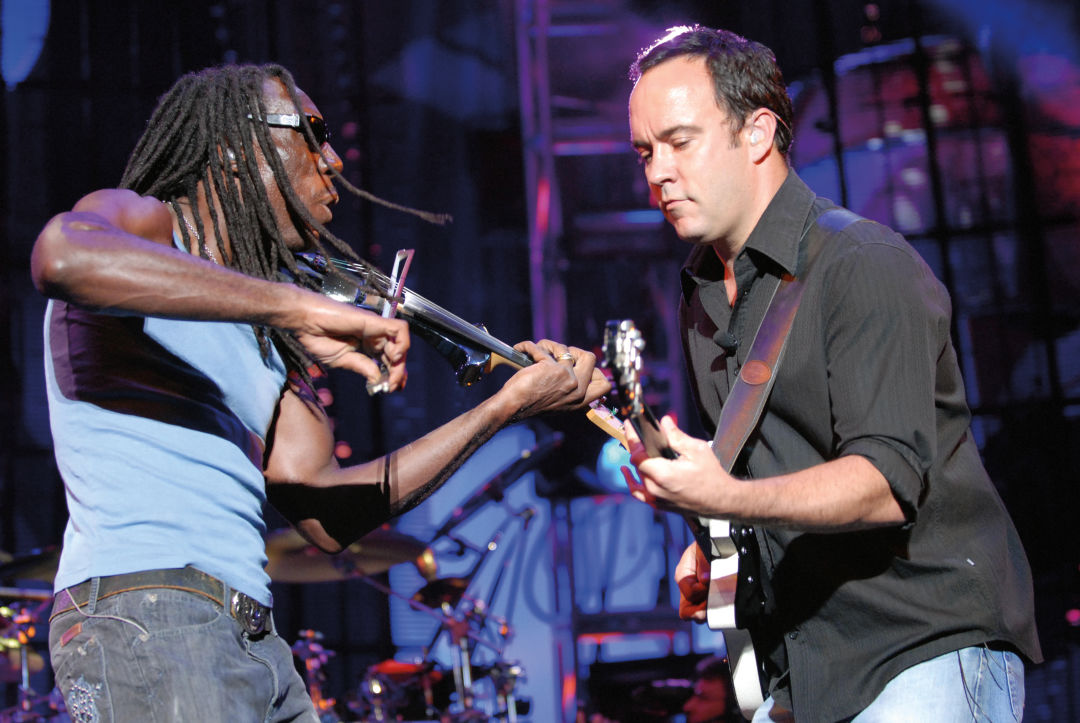
Matthews jams with now-fired violinist Boyd Tinsley in 2007.
Just how optimistic is the world of DMB? Cheery enough to make a holy relic of freeway signage. The exit 143 sign on I-90 is unremarkable, regulation brown with white lettering that reads “The Gorge Amphitheater, next right.” But on the Friday of Labor Day weekend three cars pull off the right lane—on yes, the interstate—to where the blacktop gives way to gravel and then bleached yellow knee-high grass. As semis whiz past on their way to Spokane or even I-90’s end point in Boston, Dave fans pose for photos with the exit 143 sign.
“It’s just like this last mile marker of, alright, we’re about to turn into heaven,” says 38-year-old Nathaniel Shoshan, who’s pilgrimaged from Florida every summer since 2008. It’s probably the only place in Washington where anyone’s attributed celestial origins to a DOT installation.
Shoshan and his friends, a collective known as the DMB Gorge Crew, circle their tents at a campsite, erecting sunshades and a giant inflatable unicorn floatie as a couch. During the day the temperature spikes to 90.
It smells like bacon, not patchouli. Everyone’s doing yoga. No one has a Hacky Sack. Flags snap in the wind, tied to lengths of PVC pipe or RV antennae, many adorned with DMB’s ubiquitous logo, which looks more like a praying mantis than a dancing figure (it’s the latter).
When the front gates open and the throng moves from campsites to the amphitheater, the biggest lines form immediately at the merch tents hawking $35 T-shirts and $60 blankets. The limited-edition poster, at $50 a pop, sells out before the opening act finishes onstage.
It’s barely an exaggeration to say there are more persons of color on stage than in the crowd of 20,000. But it also isn’t the Seattle crowd you’d expect; no Patagonia puffies, few tech bro button-ups.
There are lines for Bud Light but none at the craft beer tent pouring 10 Barrel, and there’s a palpable buzz to the crowd. Ardent fans dance in the pit up front but in the back rows of the lawn, the music is less a central attraction and more like a soothing white noise. The Gorge becomes a sensory deprivation chamber where the outside world—politics, war, global warming, Pitchfork thinkpieces, petty workplace peeves—has no relevance.
Dave isn’t feeling chatty, his only stage banter about the joys of camping: “Don’t be afraid to fart in the sleeping bag. Prrrrrrt. That’s camping!”
Through more than two hours, he’s backed up by the only other original DMB members left, drummer Beauford and bassist Lessard. There are murmurs among fans about whether it’ll be “the same without Boyd” now that towering violinist Tinsley, long the most charismatic stage presence, is gone.
Dave himself announced Tinsley’s leave of absence in early 2018; months later news broke that the string player was accused of sexual harassment. Tinsley’s alleged target, a Seattle-based trumpet player, filed a $9 million suit in May accusing the violinist of lewd acts and “creepy, sex-based behavior.” Tinsley’s DMB status was updated to a firing.
As an encore, Dave croons the title song from his new album. It’s about an old man who curses and spits, who bemoans that “It’s all going to hell and the whole world is broken.” Darker than the eat-drink-and-be-merry refrains of old, but the chorus resolves with “Come tomorrow, we gonna find a way.” It’s a little bit sweet and a little bit of procrastination for a generation that never got around to building a better world.
After the show, a cluster of 20-something men stand around a firepit fueled by a propane line—all the warmth and flicker of a wood campfire without the aroma or ash.
The men are friends—maybe some are brothers, it’s not quite clear—with roots in Butte, Montana. They extol the virtues of their Big Sky town, waxing nostalgic even for the copper mine Superfund site on the city border. Now scattered throughout the west, the guys regroup here every year. Their annual Gorge retreat is more tradition than fandom.
And last year, 2017, the only year Dave Matthews Band skipped the Gorge since the ’90s? Around the fire the men give blank looks when asked what they did instead.
“Nothing,” says one.
That word keeps coming up around here at the Gorge, a space named for a void carved back in the ice ages. Later, I peer down at the outfit I’ve created to bridge the temperature spikes of Central Washington: fuzzy alpaca socks inside open-toed Teva sandals.
“Real fashion nightmare,” I say aloud, vaguely apologetic.
“It’s okay,” says a fan—reassuring, earnest—as we stroll between campsites, where we’ll drink more beer and be more merry. Then do the same thing tomorrow. “Nothing matters here.”
